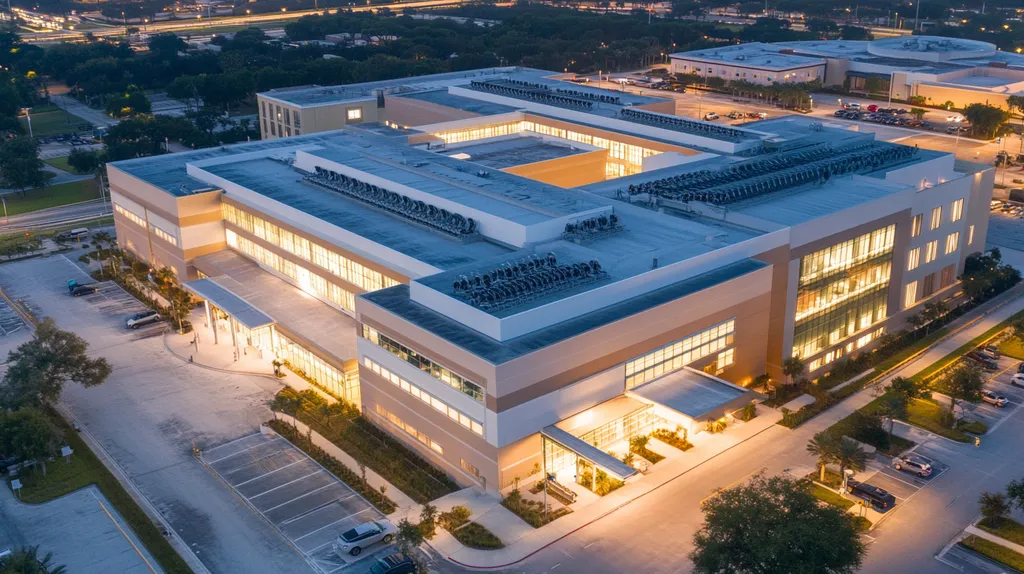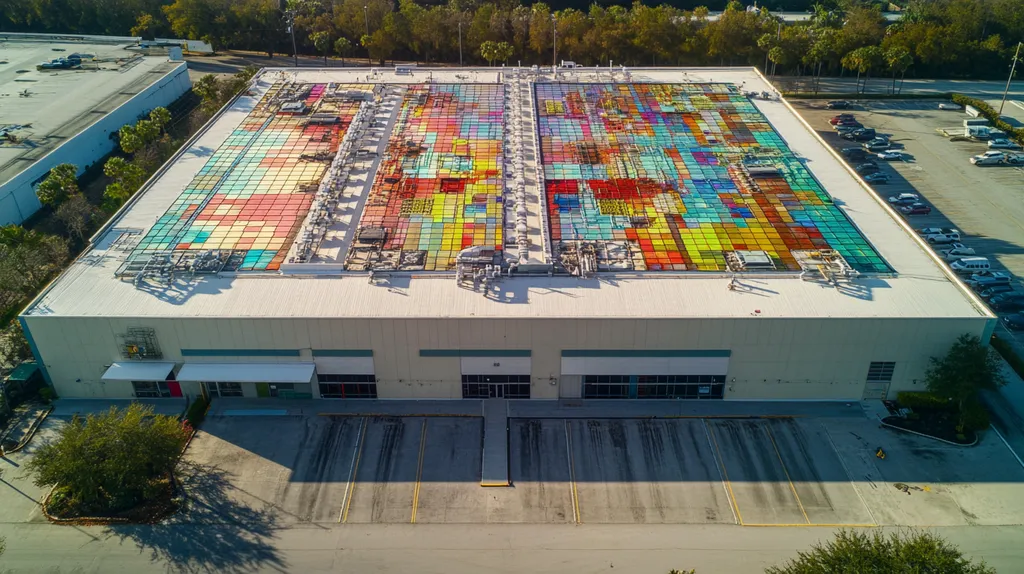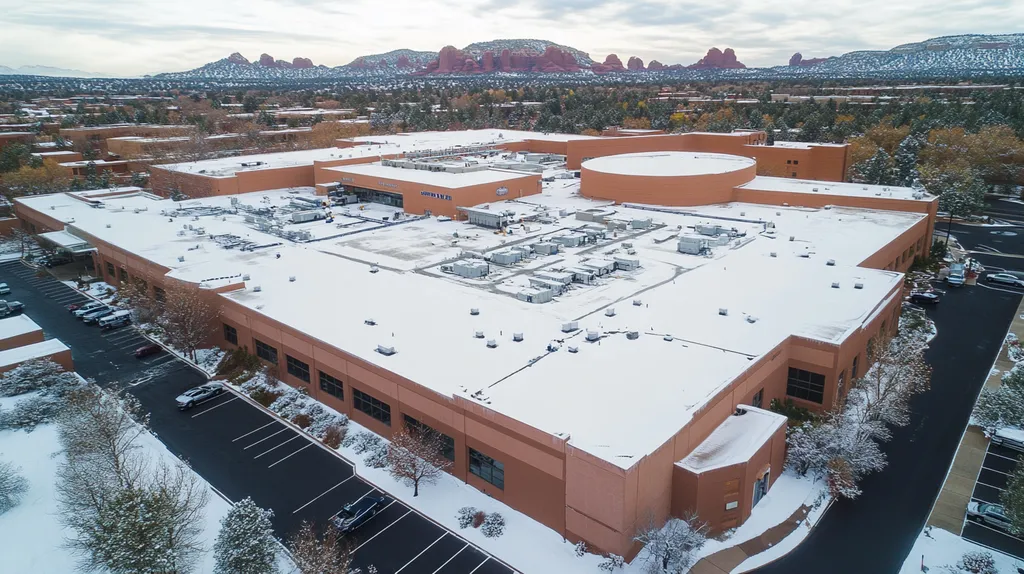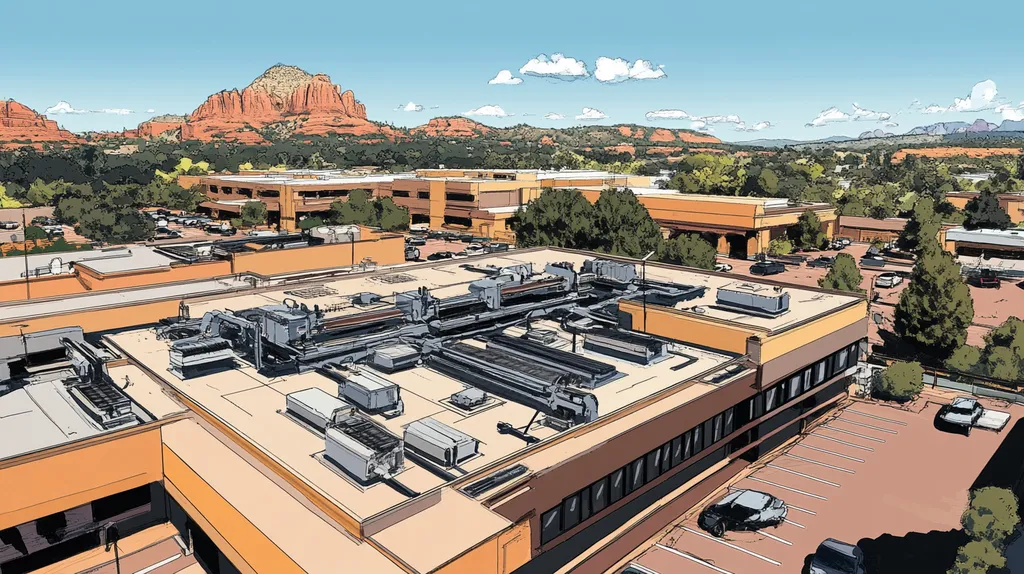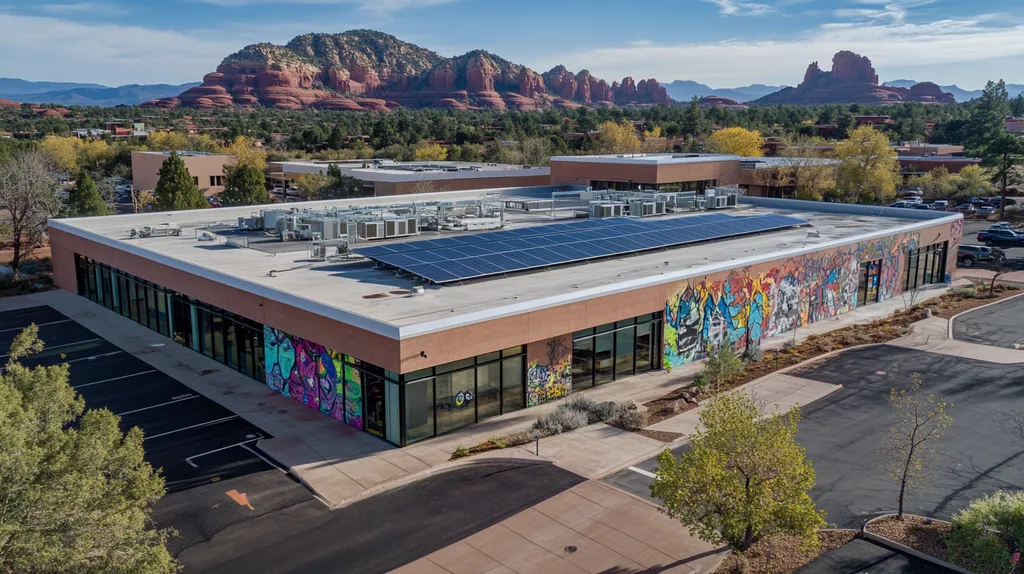Commercial property owners lose up to 30% of their buildings’ heating and cooling energy through poorly insulated roofs, resulting in millions of dollars in preventable costs each year.
As energy prices continue to climb and sustainability requirements tighten, optimizing roof insulation systems has become a critical priority for facility managers and building professionals.
This comprehensive guide examines the key factors affecting insulation performance, from thermal resistance to moisture control, while providing actionable solutions for enhancing energy efficiency and reducing operational expenses.
SECTION 1: PERFORMANCE FACTORS
For property owners and facility managers, grasping the performance factors of roof insulation is critical. Inadequate insulation not only spikes energy costs but also creates uncomfortable indoor climates. In fact, nearly 30% of a building’s heating and cooling energy can be lost through poorly insulated roofs. Taking charge of insulation solutions enhances energy efficiency, meets building codes, and supports sustainability objectives. This section will dive into thermal resistance, the impact of heat transfer, and the essential role of ventilation in maximizing roof insulation systems.
Thermal Resistance and R-Values
Thermal resistance, denoted as R-values, reflects how well a material can resist heat flow. Higher R-values indicate superior insulation, resulting in reduced energy consumption. For example, a roof with an R-value of 30 is significantly more efficient than one rated at 15. Property owners should prioritize insulation materials that match their local climate to improve energy performance.
It’s important to choose insulation that goes beyond just the minimum requirements. Advanced materials such as polyisocyanurate or spray foam offer better R-values than conventional fiberglass batts. Investing in high-R-value insulation may involve higher upfront costs, but it often leads to substantial long-term savings in energy bills and enhanced indoor comfort.
Moreover, insulation requirements can differ based on factors like roof type and building usage. For facilities with expansive roof areas, such as warehouses, precise insulation choices are crucial. A thorough R-value assessment is vital for increasing overall energy efficiency, serving as a fundamental aspect of effective roofing strategies.
Key Action Items
Heat Transfer and Energy Consumption
Heat transfer is a primary factor affecting energy consumption in commercial buildings. A significant amount of heat moves in and out through the roof, influencing both cooling and heating needs. A poorly insulated roof can spike cooling requirements by as much as 50% during warm months, forcing HVAC systems to work harder and incurring higher operational costs.
Understanding the modes of heat—conduction, convection, and radiation—is vital for effective roofing design. Property managers need to consider how these heat transfer methods impact their buildings. Options such as reflective or cool roofing materials can help minimize heat absorption, ultimately boosting overall energy efficiency. Utilizing light-colored materials can deflect sunlight, leading to lower indoor temperatures and reduced energy costs.
Effective insulation also serves as a barrier against unwanted heat transfer. Designing roofs to minimize heat movement is essential for maintaining comfort and efficiency. Facilities that comprehend these principles can make smarter decisions about their roofing systems to enhance energy performance.
Key Action Items
Ventilation and Moisture Control
Ventilation is a critical component of effective roof insulation systems. Adequate airflow regulates temperature and moisture, which is essential for preventing mold growth and structural damage. Buildings lacking proper ventilation may experience trapped heat and humidity, resulting in deteriorating insulation materials and soaring energy use.
For instance, inadequate ventilation can lead to a 10% rise in annual energy costs due to excess humidity and heat. Implementing smart design strategies, such as installing roof vents and utilizing breathable insulation, can mitigate these issues significantly.
Additionally, being aware of the building’s lifecycle and seasonal weather helps inform effective ventilation strategies. For example, adjusting vent positions during milder weather can harness natural airflow to better regulate indoor climates, ultimately reducing the HVAC load.
Key Action Items
SECTION 2: FINANCIAL CONSIDERATIONS
For property owners and facility managers, understanding the financial implications of roof insulation systems is not just important—it’s essential. Inefficient insulation can lead to wasted energy and inflated utility bills, while a well-implemented system enhances overall building efficiency. Research indicates that energy-efficient roofing can reduce energy costs by up to 30%. This section will explore initial installation costs, potential long-term savings, and ongoing maintenance expenses, offering a thorough perspective on the financial landscape involved.
Initial Installation Costs
The initial investment in high-quality insulation can seem daunting. Property owners often face significant upfront costs that encompass materials and labor. However, investing in premium insulation doesn’t just add value—it improves building performance and reduces operational costs over time.
In an effort to minimize short-term spending, many professionals gravitate toward lower-cost options. This choice can be counterproductive, leading to increased energy consumption and higher costs in the future. Opting for a higher-rated insulation system presents benefits that can mitigate the initial expense.
For instance, while a reflective insulation layer might bear a higher initial price tag, it can effectively cut cooling costs during the sweltering summer months. Carefully assessing these costs against the resulting energy savings is crucial for sustainable financial planning.
Key Action Items
Long-Term Energy Savings
Investing in an efficient insulation system can translate into significant savings over time. Quality insulation minimizes the need for heating and cooling, leading to reduced energy consumption. Studies suggest that buildings with optimal insulation can enjoy savings of up to 30% in annual energy expenses.
For instance, a well-insulated commercial building may witness considerable reductions in cooling costs during summer, leading to annual savings of hundreds or even thousands of dollars. These financial benefits become even more pronounced as energy prices continue to rise over time.
Furthermore, numerous governmental incentives are available for energy-efficient upgrades, further enhancing the potential for savings. These tax credits and rebates can significantly lessen the initial financial impact of insulation enhancements.
Key Action Items
Maintenance and Replacement Expenses
Maintenance costs for roof insulation systems can vary significantly based on the selected materials and local climate. Regular maintenance is key to ensuring insulation operates effectively throughout its lifespan. Failing to carry out routine upkeep can lead to material degradation, necessitating costly replacements.
For example, foam insulation typically demands less ongoing maintenance compared to fiberglass, which often requires periodic inspections and replacements. Understanding each insulation material’s requirements can steer facility managers toward informed choices.
In addition, property owners should allocate funds for future replacement expenses. Over time, as insulation ages, its efficiency diminishes, potentially raising energy costs. Budgeting for timely replacements facilitates smoother transitions and sustained energy efficiency.
Key Action Items
SECTION 3: COMPLIANCE REQUIREMENTS
For property professionals, comprehending compliance requirements is essential when seeking to optimize roof insulation systems. Adhering to local building codes and energy efficiency regulations not only minimizes operational costs but also supports sustainability efforts. Research shows that buildings compliant with these standards can reduce energy consumption by as much as 30%. This section will address the critical components of local building codes, energy efficiency regulations, and relevant certification systems to ensure compliance and maximize performance.
Local Building Codes and Standards
Local building codes and standards outline the minimum requirements for construction, including insulation systems. These codes can differ significantly from one region to another and are often updated to reflect new energy efficiency goals. Property owners must stay informed about these codes, as non-compliance can result in hefty fines or mandatory renovations.
For instance, many jurisdictions have adopted the International Energy Conservation Code (IECC), which specifies insulation values that roofs must meet. Complying with these regulations not only ensures adherence but also promotes the durability of the roof system.
Additionally, local codes may mandate that specific insulation materials achieve fire safety ratings, which is crucial for both compliance and the safety of occupants. Consulting local regulations before making insulation decisions is vital to ensuring overall safety and compliance.
Key Action Items
Energy Efficiency Regulations
Energy efficiency regulations set the standards for performance, advocating for reduced energy consumption in commercial buildings. In numerous areas, these regulations outline specific insulation R-values that must be achieved to qualify for incentives or rebates. Property managers must understand these regulations to effectively cut energy costs.
For example, the Energy Policy Act promotes energy-efficient roofing systems through tax incentives. Properties that meet specific energy performance benchmarks can realize considerable financial benefits, underscoring the connection between compliance and reduced operational costs.
As green building certifications like LEED (Leadership in Energy and Environmental Design) become more prevalent, energy efficiency regulations are evolving. This necessitates a proactive stance from property owners to ensure their roofing systems comply while also contributing to broader sustainability goals.
Key Action Items
Certification and Rating Systems
Certification and rating systems are critical in providing a framework for assessing the performance of insulation systems. Labels like Energy Star and LEED help property owners measure energy efficiency and environmental impact effectively. A strong grasp of these systems can significantly enhance decision-making regarding roofing solutions.
For instance, roofs with the Energy Star label generally showcase superior thermal performance, helping to lower cooling costs—especially vital in warmer climates where energy demand surges during peak seasons.
Furthermore, the LEED certification process includes an assessment of overall building sustainability, encompassing insulation quality. Pursuing these certifications not only elevates property value but also demonstrates a commitment to energy efficiency and environmental responsibility.
Key Action Items
SECTION 4: RISK MANAGEMENT
Effective risk management is essential for ensuring the performance and longevity of commercial roofing systems. Poorly insulated roofs can lead to significant weather-related damage, heightened fire hazards, and weakened structural integrity. Alarmingly, the National Roofing Contractors Association estimates that inadequate insulation may be responsible for up to 30% of energy loss, amplifying these risks. Property professionals must adopt proactive insulation strategies to mitigate potential dangers and protect their investments.
Weather-Related Damage Prevention
Weather-related damage poses a serious risk to any commercial roof. Proper insulation plays a vital role in shielding against moisture and temperature fluctuations. For example, roofs equipped with high R-value insulation can effectively defend against ice dams, which can lead to both leaks and structural damage.
Additionally, proper insulation helps combat overheating during the summer months, minimizing stress on roofing materials. This protective layer is crucial not just for immediate maintenance but also as a long-term investment that extends the roof’s lifespan and reduces costly repairs.
Regular inspections are key to catching early signs of weather-related wear and tear. Property owners should remain vigilant about the condition of their insulation and take swift action to correct any deficiencies. This proactive approach significantly enhances the building’s resilience against weather-related challenges.
Key Action Items
Fire Resistance and Safety
Fire hazards remain a critical concern for commercial roofs, and insulation materials play a significant role in safety. Different insulation types come with varying fire ratings; making informed selections can spell the difference between safety and disaster. For instance, fiberglass insulation generally provides superior fire resistance compared to polystyrene options.
Organizations must prioritize the fire safety of their roofing systems when designing or renovating their facilities. Using insulation with fire-resistant properties can slow the spread of flames, providing invaluable extra time for evacuation during emergencies.
Conducting regular fire safety assessments is crucial in maintaining high safety standards. Facility managers should confirm that insulation materials comply with industry regulations to protect lives and may even lower related insurance premiums. In the long run, investing in fire-resistant insulation often results in lower insurance costs and mitigates potential fire damage.
Key Action Items
Structural Integrity and Durability
The structural integrity of a commercial building is closely linked to its roofing system. Inadequate insulation can accelerate wear and tear, compromising stability over time. For instance, failing insulation can lead to moisture buildup that fosters mold growth and rot, threatening the roof’s lifespan.
Additionally, roofs lacking sufficient thermal resistance may require more frequent repairs, contributing to rising redevelopment costs. Property professionals should recognize that optimizing insulation strategies can significantly enhance the roof’s durability and reduce future maintenance needs.
Conducting routine structural assessments is essential for ensuring ongoing roof integrity. Adequate insulation acts as a barrier against direct damage while also reinforcing the roof’s ability to endure environmental stresses, such as heavy winds or snowfall.
In conclusion, prioritizing durable insulation solutions generates long-term benefits for structural stability while decreasing risks presented by environmental factors. Robust insulation is more than an energy-saving measure; it is foundational to a resilient commercial roofing strategy.
Key Action Items
SECTION 5: OPERATIONAL PROCEDURES
In the world of commercial roofing, having robust operational procedures is vital to maximizing the effectiveness of insulation systems. Regular inspections and maintenance can greatly improve energy efficiency and lower operating costs. Research shows that a well-maintained roof can save as much as 20% on energy bills every year. Property owners and facilities managers must prioritize these procedures to ensure peak insulation performance.
Regular Inspection and Maintenance
Conducting regular inspections is essential for sustaining an efficient insulation system. Property owners should perform thorough assessments at least twice a year and immediately after severe weather events. This proactive method helps identify minor issues before they escalate into costly problems.
Special attention should be paid to roof penetrations, seams, and flashings, which are often vulnerable to water intrusion and can jeopardize insulation effectiveness. Early detection of moisture is crucial in preventing expensive energy losses down the road.
Additionally, maintaining a routine cleaning schedule is important. Removing debris that can trap heat or moisture contributes to the longevity of both the insulation and roofing systems. These straightforward maintenance tasks play a significant role in sustaining optimal roof performance.
Documenting each inspection is also vital. Keeping detailed records aids in tracking performance trends and identifying energy usage patterns, ultimately leading to better management of long-term operational costs.
Key Action Items
Repair and Replacement Protocols
Having clear protocols for repairs and replacements is essential for reducing costs linked to insulation failures. In instances of detected insulation damage, prompt action is crucial to prevent worsening conditions. Wet or damaged insulation can lose nearly 50% of its effectiveness, leading to inflated energy bills.
Regular evaluations should determine whether a repair or complete replacement is needed. Small fixes might include sealing seams or patching areas, while significant damage might warrant full insulation replacement. Thorough guidelines are necessary for property teams to make informed decisions.
After any repairs or replacements, reassess the entire roofing system. Verifying that all components work in harmony preserves energy efficiency and confirms that issues are properly resolved, preventing future complications.
Investing in high-quality materials during replacements is vital. Using advanced insulation products enhances thermal performance and durability. Quality materials typically come with better warranties, ensuring long-term protection against energy loss.
Key Action Items
Professional Installation Guidelines
To achieve optimal insulation performance, engaging professional installers is critical. Qualified roofing contractors ensure that insulation systems are set up according to established industry standards. Poor installation can lead to inefficiencies and escalate long-term costs.
Contractors must be well-versed in the specific insulation types and systems chosen for the building, considering the unique requirements of the commercial structure and local climate factors that affect performance.
Before installation begins, a thorough assessment of the roof’s existing condition is necessary. This evaluation facilitates customized solutions that address any structural challenges or maintenance complications discovered.
After completing the installation, contractors should provide comprehensive documentation. Information about insulation types, performance criteria, and maintenance needs helps facilities managers ensure continued efficiency over time. Additionally, ongoing training for in-house personnel ensures adherence to best practices.
Key Action Items
SECTION 5: OPERATIONAL PROCEDURES
In the world of commercial roofing, solid operational procedures are critical for maximizing insulation effectiveness. Regular inspections and maintenance can significantly boost energy efficiency while lowering operating costs. Research indicates that well-maintained roofs can save as much as 20% on annual energy bills. Property owners and facility managers must prioritize these procedures to achieve optimal insulation performance. This section will explore the importance of routine inspections, effective repair protocols, and the necessity of professional installations.
Regular Inspection and Maintenance
Regular inspections are essential for maintaining an efficient insulation system. Property owners should conduct thorough checks at least twice a year and immediately after severe weather events. This proactive approach helps uncover minor issues before they escalate into significant problems.
Special attention should be paid to areas around roof penetrations, seams, and flashings, as these spots are often vulnerable to water intrusion. Early detection of moisture can help prevent costly energy losses and repairs.
A routine cleaning schedule is also necessary to remove debris that can trap heat or moisture. Such accumulations can deteriorate insulation over time, leading to increased energy demand. Simple maintenance tasks play a critical role in sustaining the longevity of both roofing and insulation systems.
Documenting each inspection is crucial. Maintaining detailed records aids in tracking performance trends and identifying patterns in energy usage, which supports effective long-term operational cost management.
Key Action Items
Repair and Replacement Protocols
Establishing clear protocols for repairs and replacements is essential to reduce costs associated with insulation failures. When insulation damage is detected, taking swift action is vital to prevent escalating conditions. Moisture-damaged insulation can lose nearly 50% of its effectiveness, resulting in increased energy expenses.
Routine evaluations should be conducted to determine whether a repair or complete replacement is necessary. Minor repairs may include sealing seams or patching areas, while significant damage might require full insulation replacement. Having clear guidelines aids property teams in making informed decisions.
After any repairs or replacements, it is advisable to reassess the entire roofing system. Ensuring all components function harmoniously preserves energy efficiency and confirms that previous issues have been effectively addressed.
Investing in high-quality materials during replacements is crucial. Using advanced insulation products can enhance thermal performance and durability. Quality materials typically come with better warranties, providing long-term assurance against energy loss.
Key Action Items
Professional Installation Guidelines
To achieve optimal insulation performance, engaging professional installers is essential. Qualified roofing contractors ensure that insulation systems are installed according to industry standards. Improper installation can lead to inefficiencies and increased long-term costs.
Contractors should have expertise in the specific insulation type and system chosen for the facility, taking into account the unique requirements of the commercial structure and local climate factors that affect performance.
Before installation, a thorough assessment of the roof’s existing condition is necessary. This evaluation allows for tailored solutions that address any structural challenges or maintenance issues discovered.
After completion, contractors should provide comprehensive documentation about insulation types, performance specifications, and maintenance needs. This empowers facilities managers to ensure continued efficiency over time. Additionally, ongoing training for in-house personnel ensures adherence to best practices.
Key Action Items
Looking Ahead
With energy costs continuing to rise by 5-7% annually, optimizing commercial roof insulation systems has never been more critical for property professionals.
Studies show that buildings with properly maintained insulation systems reduce energy consumption by up to 30% while extending roof lifespans by 25-40%.
Success requires a comprehensive approach: selecting appropriate materials based on climate conditions, ensuring professional installation, maintaining strict inspection protocols, and staying current with evolving energy codes.
The future of commercial roofing lies in smarter, more efficient insulation solutions that balance initial costs against long-term savings while supporting broader sustainability goals.
Property owners who act now to optimize their roof insulation systems position themselves for significant competitive advantages in an increasingly energy-conscious market.
FREQUENTLY ASKED QUESTIONS
Q. What performance factors impact the effectiveness of a commercial roof’s insulation?
A. Performance factors such as thermal resistance, heat transfer, and ventilation play crucial roles. Inadequate insulation can lead to increased energy bills and discomfort. Understanding these factors helps property owners enhance energy efficiency and comply with building codes.
Q. How do financial considerations affect a commercial roof’s insulation choices?
A. Financial considerations include initial installation costs, long-term energy savings, and maintenance expenses. While high-quality insulation requires a larger upfront investment, it often results in reduced energy costs over time, making it a wise long-term choice for property owners.
Q. What are the key compliance requirements for a commercial roof’s insulation system?
A. Compliance requirements involve adhering to local building codes, energy efficiency regulations, and certification systems. Staying informed about these standards ensures your roof insulation reduces energy consumption and avoids legal issues, promoting sustainability and cost efficiency.
Q. How can property owners prevent weather-related damage to their commercial roofs?
A. Property owners can prevent weather-related damage by ensuring their insulation is properly installed and maintained. Regular inspections help catch early signs of wear, while high R-value insulation mitigates moisture and temperature fluctuations, protecting the roof from damage.
Q. What are the essential operational procedures for effective commercial roof insulation?
A. Essential operational procedures include regular inspections, routine maintenance, and having clear repair protocols. Documenting findings and ensuring that repairs are performed promptly helps sustain insulation effectiveness, ultimately improving energy efficiency and reducing long-term costs.
Q. How can insulation materials affect fire safety in commercial roofs?
A. Different insulation materials possess varying fire ratings, impacting safety. Selecting fire-resistant insulation materials can slow flame spread, thus increasing safety for building occupants. Regular fire safety assessments ensure compliance and reduce potential risks related to fire hazards.
Q. What are the benefits of using reflective materials for an industrial roof?
A. Reflective materials can significantly reduce heat absorption, improving energy efficiency in industrial roofs. They help lower indoor temperatures during summer, decreasing cooling costs and enhancing overall roof performance—benefiting both the environment and the bottom line.

